Excerpts from Jim Conrad's
Naturalist Newsletter
Entry dated April 19, 2024, from notes taken about 1.5km northeast of Puerto de los Velazquez, Municipality of Pinal de Amoles; N21.138°, W99.665°, elevation ~2780 meters (~9120 feet); oak/pine forest on limestone bedrock; in the Eastern Sierra Madre Mountains of east-central Querétaro state, MÉXICO
PACKERA SANGUISORBAE
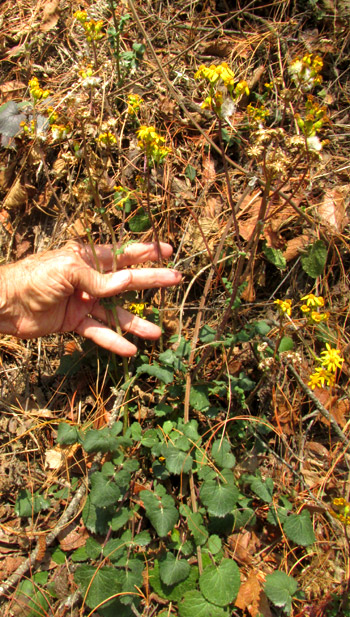 In a borderline cloud-forest atop a ridge, the wildflower at the right looked familiar, but a little different. It was like the Butterweed up north which, during very early spring, just as buds on certain trees start to open, convey a soft, diffuse greenness to the otherwise leafless gray forest. Often Butterweeds form dazzlingly bright yellow splotches in fields, and cover spongy floors of swampy forests soon to be submerged by spring rains. This ridgetop Mexican species looked almost the same, but no northern Butterweed would grow in this high-elevation oak-pine forest.
In a borderline cloud-forest atop a ridge, the wildflower at the right looked familiar, but a little different. It was like the Butterweed up north which, during very early spring, just as buds on certain trees start to open, convey a soft, diffuse greenness to the otherwise leafless gray forest. Often Butterweeds form dazzlingly bright yellow splotches in fields, and cover spongy floors of swampy forests soon to be submerged by spring rains. This ridgetop Mexican species looked almost the same, but no northern Butterweed would grow in this high-elevation oak-pine forest.
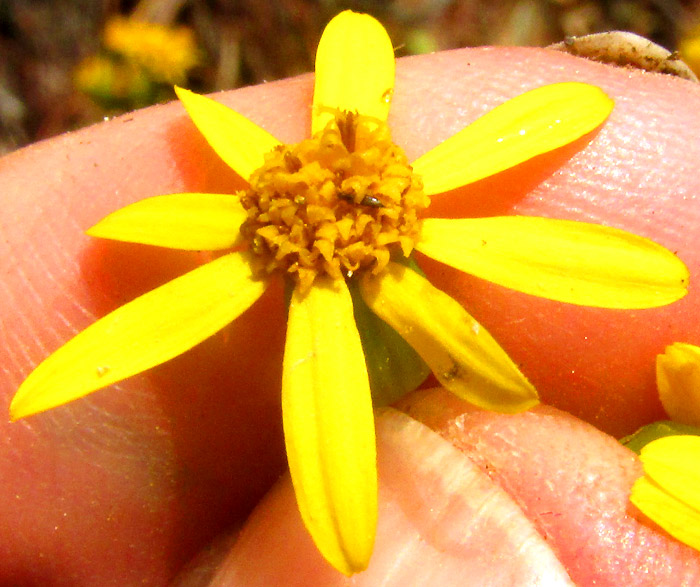
Also, Butterweed flowering heads bear around 10-13 petal-like ray florets, while our ridgetop species seemed satisfied with about seven or eight. Butterweed heads usually squeeze 35-50 cylindrical disc florets into the head's center, while our ridgetop heads mostly did with 15-25.
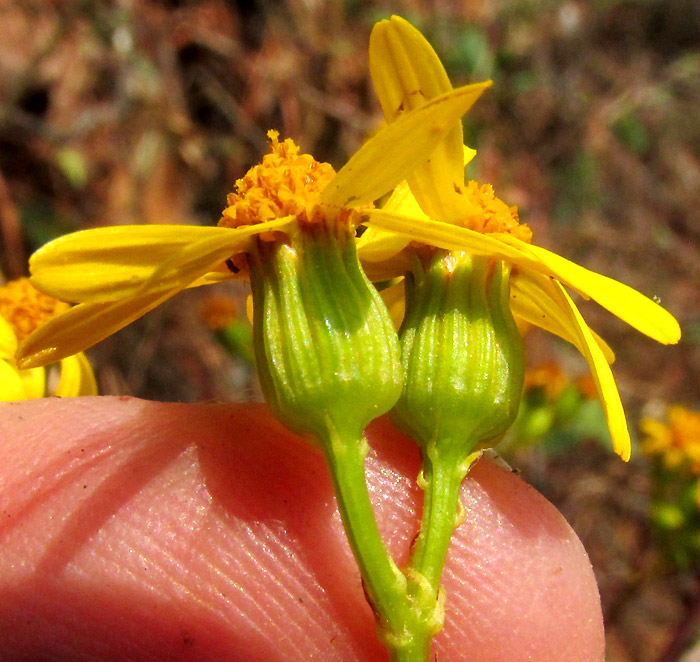
Our ridgetop plant's green, urn-shaped involucre enveloping the florets' lower parts was composed of 13 or 14 scale-like bracts, while Butterweeds needed 20 or so. However, in both species, the involucral bracts were of nearly the same length as its neighbors, with whom they stood side by side without overlapping. That's a field mark for the genus in which both Butterweeds and our plant belong, the genus Packera, of which most species often are known as groundsels or ragworts. Later, while identifying our ridgetop species, it was useful to notice that the above heads arise on stem-like peduncles not more than 13mm long (~½ inch), not considerably longer.
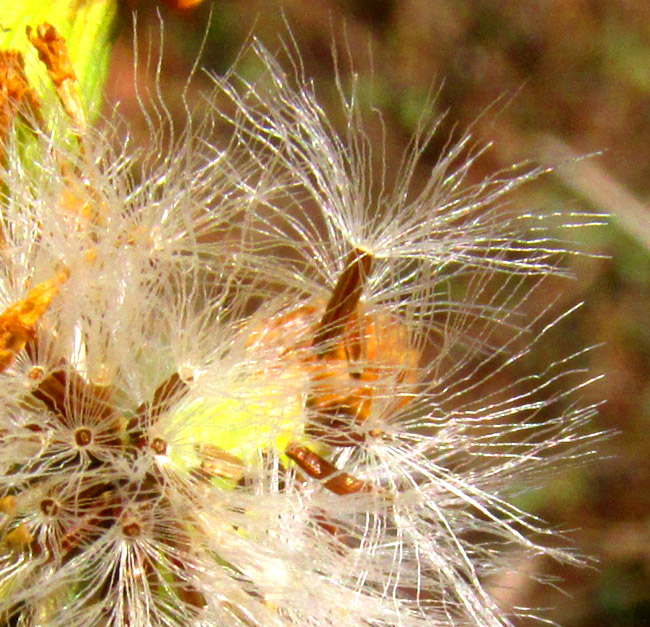
Some heads had matured and now bore clusters of brown, one-seeded, cypsela-type fruits, each cypsela topped with numerous slender, white hairlike items. Wind caught in these hairs, enabling the cypselae to parachute away from the mother plant.
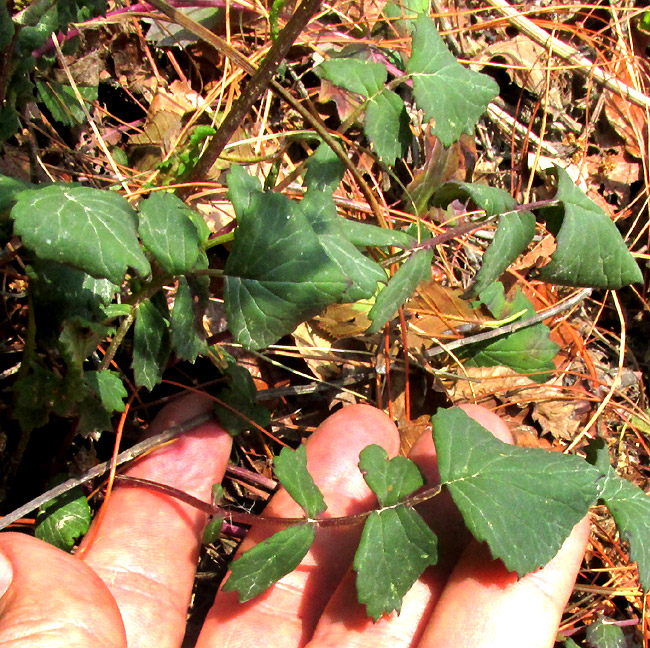
As with Butterweed, leaves on our Packera clustered at the plant's base, and were pinnately divided. This species' terminal leaflet was larger than the others, with a somewhat squared base. All leaflets were toothed along their margins.
Currently Kew's Plants of the World Online database recognizes 76 Packera species, all native to an area embracing North America, Siberia, and the Mexican uplands. The 2012 work by José Luis Villaseñor and Enrique Ortiz entitled "La Familia Asteraceae en la Flora del Baío y de Regiones Adyacentes" lists five species documented for the upland central Mexican region known as the Bajío, where our plant grows. Among those five species, any plant with leaves and flowers as shown above is PACKERA SANGUISORBAE.
Packera sanguisorbae is known by no English name, though no one would object if you just called it a groundsel or ragwort. It's endemic just to Mexico's uplands south into Oaxaca, in forests of oak, pine and fir.
Apparently the species name sanguisorbae, which means "bloodsucker," is meant to note the similarity between our plant's pinnately divided leaves and those of Europe's Great Burnet wildflower, Sanguisorba officinalis. Most likely, that plant's genus name Sanguisorba reflects the species' long history in traditional medicine of stopping bleeding (blood-sucking), among other uses. However, our species and Great Burnet produce flowers and fruits which are altogether different, the plants belonging to different families.
The 2002 study by Olga Lydia Loredo-Medina and others entitled "Aprovechamiento de Recursos Vegetales en una Localidad de La Reserva de la Biosfera Mariposa Monarca, Michoacán, México," lists plants found useful by people in eastern Michoacán state, Mexico. Packera sanguisorbae is listed as having its upper parts used to make a tea for treating stomach ache. Also the plant is used against susto and espanto. Those terms literally mean "fear," but it's understood that they refer to something far more complex than merely being afraid of something.
Cures for susto I've seen consisted of the healer circling the patient while vigorously brushing the body with powerfully aromatic, often minty herbage. Packera sanguisorbae isn't odoriferous, but maybe being cleansed with brightly golden flowers might calm a spirit. The species also is used for the aire, or "air," usually referring to a bloated stomach, but sometimes people say their muscles and other parts are hurting because air has gathered there. Also livestock eat the plant.
The work by J.F. Bain and J.L Golden, dated 2000 and entitled "A Phylogeny of Packera (Senecioneae; Asteraceae) Based on Internal Transcribed Spacer Region Sequence Data and a Broad Sampling of Outgroups," supports the notion that the genus Packera originated in Mexico.